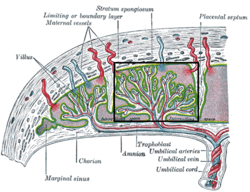Placental cotyledon
The placenta of certain mammals contains structures known as cotyledons, which transmit fetal blood and allow exchange of oxygen and nutrients with the maternal blood.
| Placental cotyledon | |
|---|---|
 Structure of the placenta, with a placental cotyledon marked in rectangle. | |
| Anatomical terminology |
Ruminants
The Artiodactyla have a cotyledonary placenta. In this form of placenta the chorionic villi form a number of separate circular structures (cotyledons) which are distributed over the surface of the chorionic sac. Sheep, goats and cattle have between 72 and 125 cotyledons whereas deer have 4-6 larger cotyledons.[1][2]
Human
The form of the human placenta is generally classified as a discoid placenta. Within this the cotyledons are the approximately 15-25 separations of the decidua basalis of the placenta, separated by placental septa.[3] Each cotyledon consists of a main stem of a chorionic villus as well as its branches and subbranches.[3]
Vasculature
The cotyledons receive fetal blood from chorionic vessels, which branch off cotyledon vessels into the cotyledons, which, in turn, branch into capillaries.[4] The cotyledons are surrounded by maternal blood, which can exchange oxygen and nutrients with the fetal blood in the capillaries.
References
- Kurt Benirschke (2007). "Placentation". Retrieved 13 January 2017.
- Erick Conard (2002). "Cotyledonary Placenta: An Easy To Understand Explanation". Retrieved 13 January 2017.
- Page 565 in: Varney, Helen; Helen Varney Burst; Kriebs, Jan M.; Gegor, Carolyn L. (2004). Varney's midwifery. Boston: Jones and Bartlett Publishers. ISBN 0-7637-1856-4.
- Gordon, Z.; Elad, D.; Almog, R.; Hazan, Y.; Jaffa, A. J.; Eytan, O. (2007). "Anthropometry of fetal vasculature in the chorionic plate". Journal of Anatomy. 211 (6): 698–706. doi:10.1111/j.1469-7580.2007.00819.x. PMC 2375851. PMID 17973911.